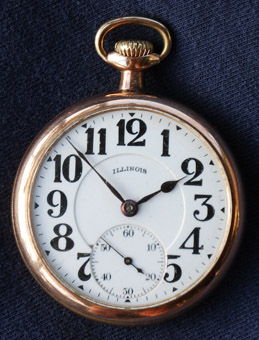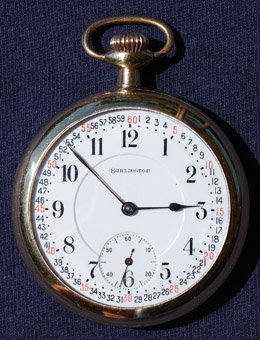Illinois Watch Company, Springfield, Illinois
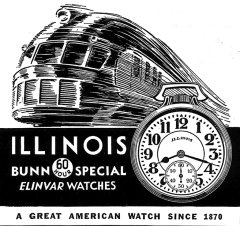 The Illinois Watch Company was first established in December 1869 as the Springfield Watch Company by John C. Adams of Massachusetts, and John Todd Stuart, William B. Miller, Dr. George Pasfield, John Whitfield Bunn, John Williams, and George N. Black, all of Springfield, Illinois. John Todd Stuart, former Congressman and early law partner of Abraham Lincoln, served as the first President of the new corporation. Construction of a factory on a 14 acre site just outside Springfield began in early 1870. Several key employees from the National Watch Company in Elgin, Illinois, joined the new company.
The Illinois Watch Company was first established in December 1869 as the Springfield Watch Company by John C. Adams of Massachusetts, and John Todd Stuart, William B. Miller, Dr. George Pasfield, John Whitfield Bunn, John Williams, and George N. Black, all of Springfield, Illinois. John Todd Stuart, former Congressman and early law partner of Abraham Lincoln, served as the first President of the new corporation. Construction of a factory on a 14 acre site just outside Springfield began in early 1870. Several key employees from the National Watch Company in Elgin, Illinois, joined the new company.
Machinery was installed and manufacturing began in the spring of 1871. The first watches were completed in January 1872. These models were made by D. G. Currier and J. K. Bigalow, and were 18 size, full plate, key wind. They were called the Stuart, Bunn, Miller, Currier, Hoyt and Mason. By the end of 1872, the corporation was producing about 25 movements per day and had sold approximately 10,000 watch movements. In 1873 a sales office was established in New York.
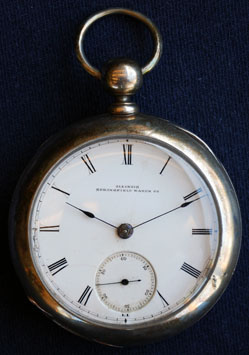 The company encountered financial difficulties following an economic downturn in the Fall of 1873. In July 1877 the corporation was reorganized and changed its name to the Illinois Springfield Watch Company, Erastus Newton Bates was selected as President of the corporation, John W. Bunn became Vice President. Otis Hoyt was appointed superintendent.
The company encountered financial difficulties following an economic downturn in the Fall of 1873. In July 1877 the corporation was reorganized and changed its name to the Illinois Springfield Watch Company, Erastus Newton Bates was selected as President of the corporation, John W. Bunn became Vice President. Otis Hoyt was appointed superintendent.
Illinois Watch Company
The Illinois Springfield Watch Company was again reorganized in the autumn of 1878, and was renamed the Illinois Watch Company. Chief executive leadership of the corporation was assumed by Jacob Bunn, Sr., an Illinois industrialist, railroad financier, railroad reorganizer, wholesale grocer, commission merchant, newspaper publisher, land developer, coal operator, political advisor and financier, banker, and rope manufacturer. Under Jacob Bunn, Sr. corporate employment grew from 260 in 1879, to 400 in 1880. In 1879, the corporation manufactured 33,285 watch movements. In 1880, the corporation manufactured 47,065 watch movements. In 1888 the compant employed 900 people and produced about 400 movements per day.1
In 1897 Jacob Bunn, Jr. became President, holding the position until his death in 1926.
In 1912 the Illinois Watch Co. constructed an astronomical observatory on the company grounds, allowing the company to measure its own time with its own equipment.
In 1913 the Illinois Watch Co. discontinued production of inexpensive watch movements and focused primarily on higher grade movements, specializing on "watch movements for the use of employees of railroads." In 1913 the Illinois Watch Co. employed 918 people and produced 525 high grade watches per day.2
18-Size Watch Movements Produced for Railroad Service
 The first group of 100 watches produced were 18-size, 15-jewel, full plate, key wind, adjusted Stuart railroad grade watches in 1872. The Bunn family surname was used on Illinois most famous railroad watch grades, starting with the first 18-size, 15-jewel, adjusted Illinois Bunn movements introduced with serial number 201. The 18-size, 15-jewel, full plate, key wind, adjusted Miller movements were also advertised as having "a good reputation with Railroad Men". All three grades were available adjusted to temperature and isochronism, with "adjusted" engraved on the balance bridge. Less expensive watch movements were also produced for general use.
The first group of 100 watches produced were 18-size, 15-jewel, full plate, key wind, adjusted Stuart railroad grade watches in 1872. The Bunn family surname was used on Illinois most famous railroad watch grades, starting with the first 18-size, 15-jewel, adjusted Illinois Bunn movements introduced with serial number 201. The 18-size, 15-jewel, full plate, key wind, adjusted Miller movements were also advertised as having "a good reputation with Railroad Men". All three grades were available adjusted to temperature and isochronism, with "adjusted" engraved on the balance bridge. Less expensive watch movements were also produced for general use.
The first stem-wind, hunting case watch, the Model 2, was produced in 1875. The stem-winding Model 2 Stuart, Bunn and Miller grades were adjusted to temperature, isochronism and positions and manufactured for railroad time service starting in 1878. The open face, stem-wind Model 3 was introduced in 1879, with the Stuart, Bunn and Miller grades manufactured for railroad time service.
Model 2, 15-jewel and Model 3 17-jewel grades No. 103 (mfg. 1883), No. 104 (mfg. 1883), No.105 (mfg. 1883), No. 106 (mfg. 1884-1887), No. 107 (mfg. 1885-1887), No. 108 (mfg. 1885-1887) and grade No. 5 (introduced in 1888), were also adjusted to temperature, isochronism and positions and manufactured to meet the requirements of railroad service.
In 1891 a new Model 4 (open face, pendant set), Model 5 (hunting case) and Model 6 (open face lever set) Bunn movements were introduced with 16-jewel, nickel plates, adjusted to temperature, isochronism and positions. Model 4 and Model 6 grade No. 5 15-jewel, gilt plates, adjusted movements were also manufactured to meet the requirements of railroad service.
In 1895-6 Illinois introduced the 18-size, 21-jewel and 24-jewel Bunn Special grade watches, both were available as open face (Model 6) and hunting case (Model 5) and were adjusted to temperature, isochronism and positions. The Bunn grade was upgraded to 17-jewel, also adjusted to temperature, isochronism and positions. The adjusted Stuart and Miller grades were discontinued.
Introduced in 1907, the 18-size, Model 6, 21-jewel, nickel plates, A. Lincoln grade was also widely used in railroad service. The Bunn grade was upgraded to 19-jewel around 1908. Production of the 18-size Bunn grade ended in 1915, the 18-size A. Lincoln grade ended in 1916, and the 18-size Bunn Special grade ended in 1919.
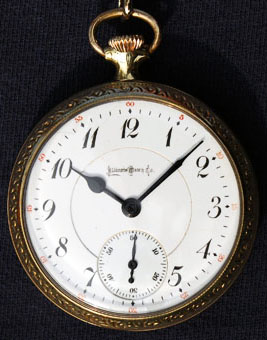 16-size Watches Manufactured for Railroad Service
16-size Watches Manufactured for Railroad Service
Illinois began producing the smaller 16-size watches with the introduction of the Model 1 (hunting case), Model 2 (open face pendant set) and Model 3 (open face lever set) movements around 1890. Grades suitable for railway service included:
- Grade No. 116 15-jewel, 16-jewel, 17-jewel and 21-jewel, adjusted to three positons. Grade No. 116 was the highest grade 16-size watch produced by Illinois during this time period.
- Grade No. 114; 16-jewel and 17-jewel "adjusted" versions, adjusted to three positons,3
- Grade No. 115 the 15-jewel, adjusted to three positions.
The Model 4 (hunting case) and Model 5 (open face) "Thin Model" movements were introduced in 1896, designed by Fred I. Getty, and featured a single exposed winding wheel, with several grades manufactured to meet railroad requirements:
- Grade No. 179, 21-jewel, adjusted to six positions, replacing grade No. 116 as Illinois highest grade 16-size watch, mfg. 1896-1898;
- Grade No. 177, 17-jewel, adjusted to six positions, mfg. 1896-1897;
- Grade No. 178, 17-jewel, adjusted to six positions, mfg. 1897-1898;
- Grade No. 176, 21-jewel, 19-jewel and 17-jewel movements, adjusted to four positions, mfg. 1896-1913.4
The Model 4 and Model 5 Sangamo grade became Illinois premier 16-size grade movement, replacing grade No. 179 around 1897. The Sangamo grade was available as 21-jewel and 23-jewel, both adjusted to six positions, and was intended for the railroad market from its inception. An advertisement in The Railway Conductor in 1903 stated the Sangamo watches "are good strong durable watches and are designed especially for railroad service where accurate time is an absolute necessity." Over 26,000 Model 4 and Model 5 Sangamo grade movements were made between 1897 and 1913.
Additional Model 4 and Model 5 railroad grade movements introduced around 1897 included:
- Grade No. 181, 21-jewel, adjusted to six positions, mfg. 1896;
- Grade No. 189, 21-jewel, adjusted to six positions, mfg. 1897-1911;
- Grade No. 187, 17-jewel, adjusted to six positions, mfg. 1898-1913;
- Grade No. 186, 17-jewel, adjusted to four positions, mfg 1898-1914;4
Grade No. 185 movements were manufactured in 17-jewel, 19-jewel and 21-jewel versions, mfg. 1898-1914. Some were adjusted to temperature meeting some electric railroad requirements others to adjusted to three or four positions meeting common turn of the century railroad requirements.4
Introduced in 1907, the Model 5 (open face), 21-jewel A. Lincoln grade was adjusted to five positions and also widely used in railroad service, with over 24,000 produced between 1907 and 1920.
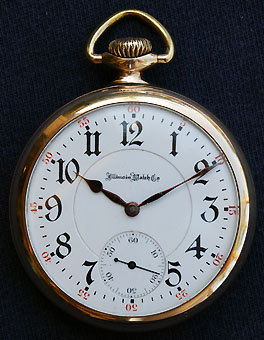 The Model 8 (hunting case) and Model 9 (open face) Sangamo Special grade were introduced in 1913, available in 19-jewel, 21-jewel and 23-jewel versions, adjusted to six positions. The Sangamo Special was considered the company's highest quality railroad watch.
The Model 8 (hunting case) and Model 9 (open face) Sangamo Special grade were introduced in 1913, available in 19-jewel, 21-jewel and 23-jewel versions, adjusted to six positions. The Sangamo Special was considered the company's highest quality railroad watch.
The Model 8 and 9 grades manufactured to meet railroad standards also included:
- Model 8 and 9 Bunn Special grades 21-jewel and 23-jewel, adjusted to six positions, mfg. 1914-1928;
- Model 8 and 9 Bunn grades 17-jewel and 19-jewel, adjusted to five positons, mfg. 1914-1924;
- Model 9 A. Lincoln, 21-jewel, adjusted to five positons, mfg. 1915-1924;
- Model 9 grade No. 770, 23-jewel, adjusted to six positions, mfg. 1913;
- Model 9 grade No. 709, 23-jewel,, adjusted to six positions, mfg. 1914;
- Model 9 grade No. 710, 23-jewel, adjusted to six positions, mfg 1912-1919;
- Model 9 grade No. 809, 23-jewel and 21-jewel, adjusted to three or six positions, mfg. 1914-1930;
- Model 9 grade No. 106, 19-jewel, adjusted to five positons, mfg. 1915-1917;
- Model 9 grade No. 107, 19-jewel and 21-jewel, adjusted to five positons, mfg. 1917-1930;
- Model 9 grade No. 108, 21-jewel, adjusted to five positons, mfg 1918-1922;
Model 9 grade No. 706 17-jewel, 19-jewel and 21-jewel versions, mfg. 1914-1929, adjusted to three or four positions, and grade No. 707 19-jewel, adjusted to three positions, mfg. 1920-1930, were manufactured to meet less demanding electric railroad requirements.4
The Model 10 Sangamo Special grade, 23-jewel, was introduced in 1917, followed by the Model 11 Bunn Special, 23-jewel, both featuring a motor barrel with a 48 hour main spring.
The Model 13 Sangamo Special grade, 23-jewel, was introduced in 1923 featuring a motor barrel with a 60 hour main spring. The Model 14 Bunn Special grade was introduced in 1924-1925, with both 23-jewel and 21-jewel versions, also featuring a motor barrel with a 60 hour main spring.
Contract Watches
The Illinois Watch Company also produced watch movements under contract for several different brands, including the Burlington Watch Company (Chicago, Illinois), whose line included high quality 19-jewel and 21-jewel railroad grade watches; the Santa Fe Watch Company (Topeka, Kansas), whose line included the 21-jewel Santa Fe Special railroad grade watch also sold mail order; the Paillard Non-Magnetic Watch Company (Chicago, Illinois), whose line included high quality 17-jewel and 21-jewel railroad grade watches; the Plymouth Watch Company (Sears Roebuck) and the Washington Watch Company (Montgomery Ward).
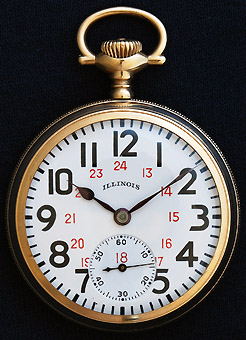 Sale to the Hamilton Watch Company
Sale to the Hamilton Watch Company
Jacob Bunn, Jr. passed on in 1926. Henry Bunn, who had been serving as Vice President, succeeded Jacob Bunn Jr. as President.
In 1928, for a sum in excess of $5,000,000, the Illinois Watch Company was purchased by the Hamilton Watch Company, which continued to operate the factory under the Illinois name and gradually shifted the emphasis from pocket to wrist watch production. The Sangamo Special grade was discontinued at the end of 1930. The Illinois Watch Company had turned out about five million watches before being sold to the Hamilton Watch Company. At its peak, the Illinois Watch Company employed approximately 1,200 people.
By November 1932, the Great Depression forced Hamilton to close the Illinois factory, though they retained possession of the brand name, with production moving to Lancaster, Pennsylvania. The 16-size Bunn Special 23-jewel and 21-jewel grades were renumbered to 163-A and 161-A, and were upgraded to include Elinvar features around 1932. Bunn Special movements were discontinued around 1948.
In the 1950's, Hamilton offered a line of Illinois and Hamilton-Illinois wrist watches with Swiss movements. These have absolutely nothing in common with the watches produced by the original Illinois Watch Company except the name.
Illinois railroad grade watches (not all were railroad approved)
The following is from list of railroad grade watches which is generally attributed Webb C. Ball. List appears to be from around 1908-1909. Not all of these were railroad approved even though all are railroad grade.
The Burlington Watch Company, ChicagoThe Burlington Watch Co., of Chicago, IL, appears to have started up around 1907 and lasted until the mid-to-late 1920s. It was a mail-order sales operation selling directly to the consumer, For about the first ten years, Burlington sold mostly 19-jewel watches, a large number of which were marketed as the Burlington Special. These watches used an Illinois Model 5 and Model 9 (Grades No. 106 and No. 107) movements. During this period Burlington contracted for a few 21-jewel, model 5, Sangamo grade movements, which was widely accepted for railroad time service. In February 1917, Burlington discontinued the 19-jewel watches and introduced a complete line of 21-Jewel Watches, adjusted to temperature and positions (the number of positions was unspecified). Perhaps the most common of the 16-size, 21-jewel Burlington watches were the Illinois-built Model 9, Grades No. 107 and No. 108. |
Illinois Production Dates by Serial Number
Note: These are approximate dates, actual dates may vary by several years. The serial number being referred to is the serial number on the movement of the watch, not the case.
| 1872 - 5,000 | 1885 - 550,000 | 1898 - 1,330,000 | 1911 - 2,300,000 | 1924 - 4,500,000 |
| 1873 - 20,000 | 1886 - 600,000 | 1899 - 1,370,000 | 1912 - 2,400,000 | 1925 - 4,700,000 |
| 1874 - 50,000 | 1887 - 700,000 | 1900 - 1,410,000 | 1913 - 2,500,000 | 1926 - 4,800,000 |
| 1875 - 75,000 | 1888 - 800,000 | 1901 - 1,450,000 | 1914 - 2,600,000 | 1927 - 4,850,000 |
| 1876 - 100,000 | 1889 - 900,000 | 1902 - 1,500,000 | 1915 - 2,700,000 | (Sold to Hamilton) |
| 1877 - 145,000 | 1890 - 1,000,000 | 1903 - 1,650,000 | 1916 - 2,800,000 | 1928 - 5,000,000 |
| 1878 - 210,000 | 1891 - 1,040,000 | 1904 - 1,700,000 | 1917 - 3,000,000 | 1929 - 5,150,000 |
| 1879 - 250,000 | 1892 - 1,080,000 | 1905 - 1,800,000 | 1918 - 3,200,000 | 1930 - 5,300,000 |
| 1880 - 300,000 | 1893 - 1,120,000 | 1906 - 1,840,000 | 1919 - 3,400,000 | 1931 - 5,400,000 |
| 1881 - 350,000 | 1894 - 1,160,000 | 1907 - 1,900,000 | 1920 - 3,600,000 | 1932 - 5,488,301 |
| 1882 - 400,000 | 1895 - 1,220,000 | 1908 - 2,100,000 | 1921 - 3,750,000 | (1933 - Moved to Hamilton) |
| 1883 - 450,000 | 1896 - 1,250,000 | 1909 - 2,150,000 | 1922 - 3,900,000 | 1934 - 5,500,000 |
| 1884 - 500,000 | 1897 - 1,290,000 | 1910 - 2,200,000 | 1923 - 4,000,000 | 1948 - 5,600,000 |
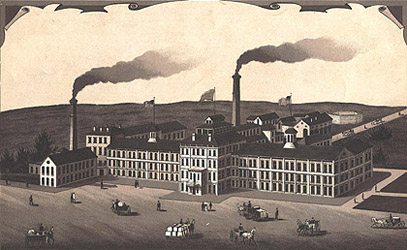
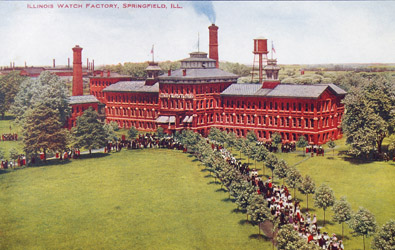
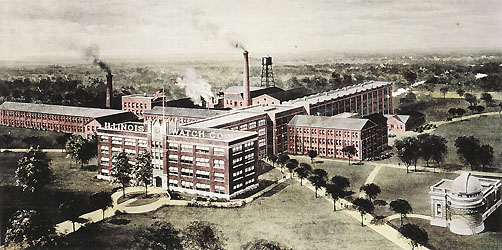
 Links to other sites for additional information:
Links to other sites for additional information:
Pocket Watch Database: - Serial number lookup and information for Hamilton, South Bend, Illinois, Rockford, Waltham & Elgin.
For additional reading:
Abbott, Henry G. The Watch Factories of America Past and Present: A complete history of Watch Making in America, from 1809 to 1888 Inclusive. Geo. K Hazlitt & Co. Chicago, 1888, reprinted by Forgotten Books, Lexington, KY, 2012.
Crossman, Charles S. The Complete History of Watch Making in America, Reprinted from Jewelers' Circular and Horological Review 1885 - 1887. Adams Brown Co. Exeter, New Hampshire.
Erhardt, Roy, Illinois Identification and Price Guide, Heart of America Press, Kansas City, MO, 1976.
Erhardt, Roy and William "Bill" Meggers Jr., American Pocket Watches: Identification and Price Guide Beginning to End, Heart of America Press, Kansas City, MO, 1987.
William Meggers, Jr. & Roy Ehrhardt, American Pocket Watches Vol. 2, Illinois Watch Co., Encyclopedia and Price Guide, Heart of America Press, Kansas City, MO, 1985.
1 Abbott, Henry G. The Watch Factories of America Past and Present: A complete history of Watch Making in America, from 1809 to 1888 Inclusive. Geo. K Hazlitt & Co. Chicago, 1888, reprinted by Forgotten Books, Lexington, KY, 2012.
2 Friedberg, Fredric J. The Illinois Watch: the Life and Times of a Great American Watch Company, Schiffer Publishing Ltd., Atglen, PA, 2004.
3 16-size Model No. 114 were manufactured with unadjusted and adjusted versions, only those marked "adjusted" were considered railroad grade watches.
4 After 1906-1908 watches adjusted to 3 or 4 positions were only accepted for service on a limited number of railroads, most mainline railroads and a number of interurban railways had raised the minimum requirement to 5 positions. Watches adjusted to 3 positions remained popular on some interurban electric railways and street railways with less demanding requirements.
American Waltham Aurora Ball Columbus Elgin National Hamilton Hampden E.Howard Illinois Peoria Rockford South Bend Seth Thomas U.S.Marion U.S.Waltham
Sharing A Heritage Railroad History Train Technology Railroad Operation Railroad Time Museums & Heritage Railroads Railroads Today

